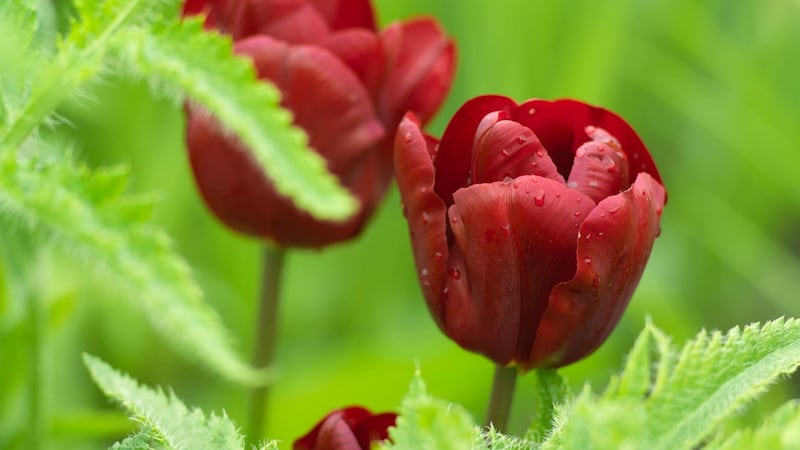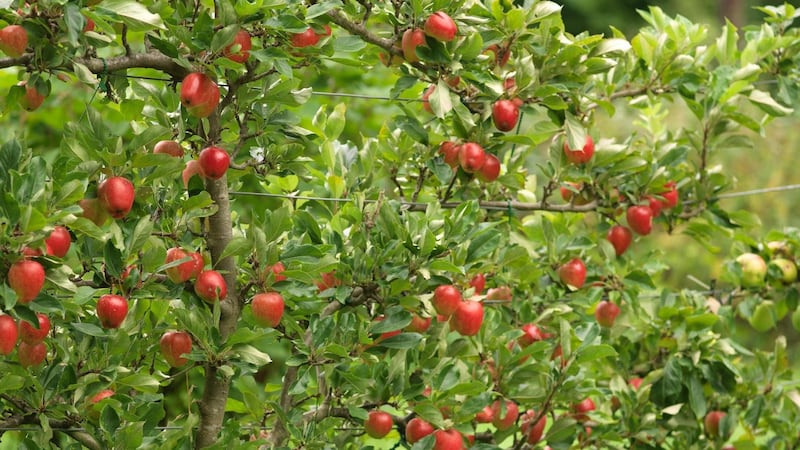When your garden is so pocket-sized that most or all of your plants grow in pots rather than in the ground, cultivating your own fruit trees might seem completely out of the question. Who has the space to grow apples, cherries, gages, plums, pears, medlars or quinces, you may snort to yourself, when every square centimetre counts? But you’d be wrong.
With Irish gardens getting ever smaller and more and more people gardening on balconies, specialist nurseries and garden centres are increasingly turning their attention to ultra-compact varieties capable of being grown very successfully in containers or tucked in tight against garden walls and fences.
True, the yields won’t be equivalent to that of a full-sized fruit tree, but then, as many of the owners of full-sized fruit trees will quietly confess, a huge harvest can sometimes be too much of a good thing.


Take, by way of example, the apple, a tree that many of us associate with the large, majestically spreading, mature specimens whose fruit-laden branches can often be seen stretching up beyond the walls of old gardens at this time of year. Capable of reaching a height and spread of six to seven metres, these orchard trees can grow large enough to fill (and densely shade) an average town garden let alone a small balcony.
Lilliputian
Harvesting the fruit requires a ladder, a head for heights, and an endless appetite for apple crumble. Some of their modern-day siblings, however, are of such Lilliputian dimensions that they are petite enough to grow in a large pot.

Why so? Much of the reason for their diminutive size is down to the particular rootstock that they are growing on. The rootstock (stay with me for the science bit) is the part of the fruit tree mainly below ground, on to which the bit above ground has been deliberately grafted, or joined, using a time-honoured horticultural technique that allows the two parts to fuse together.
When propagating fruit trees, nursery owners choose from a wide range of rootstocks, which they carefully select according to their compatibility, vigour, hardiness, disease-resistance and capacity to withstand certain growing conditions. So for example, M27, an ultra dwarfing rootstock used for apple trees, will produce a very small tree with an average height and spread of just 1.5 to 2m, while M9 will produce a height and spread of 2-3m and M26 a height and spread of 2.5-4m.
Along with using a dwarfing rootstock, different methods of pruning/training are also successfully used to keep fruit trees compact enough for the smallest of outdoor spaces. The classic example is what’s known as a single cordon (a small tree with a single vertical main stem and a series of very short lateral branches coming off it).
Apple, pear, cherry, gages and plum trees can all be grown in pots as cordons, with each tree producing up to 10kg of delicious fruit. These cordon fruit trees can also be planted in the ground (spaced just 60-80cm apart) to create your very own mini-orchard, or against a sunny wall or garden fence, or simply grown in a line to make a compact and wonderfully ornamental flowering and fruiting hedge.
If you do decide to grow them as a hedge, then plant each cordon tree at a 45-degree angle (this ensures more even growth), making sure that the slightly bulging part just above the base of the trunk (where the graft was made) is positioned about 5cm above the surface and facing upwards.
Sturdy support
Whether grown in the ground or in pots, upright or at an angle, your cordon fruit trees will need some form of sturdy support (either single wooden stakes or a system of strong lateral wires). If you’re only growing one tree, then you’ll also need to choose a self-fertile variety capable of pollinating itself. Otherwise it will need at least one other compatible variety growing nearby that flowers at the same time and can act as a pollinating partner, something that any good garden centre or nursery will advise you on.
To help keep your cordon fruit trees compact and productive, prune them in late summer, a simple process that takes no more than a matter of minutes and involves using a secateurs to nip back the growing tip, plus any new side shoots coming directly off the main stem, as well as side shoots coming off the fruiting spurs (the part of the tree carrying the fruit). As the recommended pruning regime varies slightly according to the variety of cordon fruit tree, see rhs.org.uk for more details.
Cordons aside, fruit trees can be trained in a variety of other decorative and very space-efficient ways to grow against a sunny wall or fence, including as espaliers or as fans. Or as standards/ lollipop-shaped trees perfect for a large pot.
There are also other kinds of (non cordon) fruit trees grown on dwarfing rootstocks that are compact enough to be grown outdoors in a large pot include the self-fertile “Sibley’s Patio Medlar” and “Sibley’s Patio Quince”, both of which will reach an average height and spread of 1.2m and produce splendidly decorative, pollinator-friendly spring blossom followed by pretty and delicious fruit.
All of these ultra-compact, productive trees are perfect for the tiniest of outdoor spaces. The only trade-off is that they require more favourable growing conditions to flourish than trees grown on more vigorous rootstocks. So give them a fertile, friable, moisture-retentive but free-draining soil/compost in a sunny sheltered spot.
If you’re growing them in pots, make sure they’re large enough (a minimum diameter of 60cm, bigger again for damsons and plums), use a good quality John Innes compost with added grit, keep them well watered but don’t let them become waterlogged, and give the compost a top-dressing in spring.
November is an excellent time to order and to plant these mini fruit trees, either as pot-grown specimens or as bare-root plants. Recommended suppliers include good Irish garden centres such as johnstowngardencentre.ie, online garden shops such as mrmiddleton.com (stockists of the Lilliput series of standard, lollipop-style fruit trees suitable for container-growing), coronet.ie and the UK-based terracefruits.com (specialists in ultra-compact varieties)
This week in the garden

In many ways early November marks the end of one growing year and the beginning of another. So while it may feel that the garden is going into winter hibernation, this is a great time to get beds prepped for next year, to collect leaves for leaf mulch, to continue to plant spring bulbs (especially tulips), and winter hardy varieties of garlic, and to sow seed of sweet pea as well as broad beans and winter-hardy varieties of garden peas.
November also marks the beginning of the bare-root season when winter-dormant trees, shrubs, hedging and perennials are for sale in good garden centres and nurseries at a much more affordable price than their container-grown equivalents.
Bare-root plants are exactly what the term implies – they are sold without any soil, compost or plastic pots- making them a very environmentally friendly choice for gardeners. Planted later this month while the ground is moist but still warm, their roots will establish quickly.
The only downside is that they must be handled/stored with care and planted as quickly as possible in order to prevent their vulnerable root systems from drying out before they get in the ground. If bad weather delays planting, store newly purchased bare-root plants somewhere cool and dark (but frost-free), ideally with their roots placed in a plastic bag and spritzed with water.
Before planting, soak the roots in a bucket of water and make sure to plan to the correct depth into well-prepared, weed-free soil. It’s also important to avoid planting when the ground is frozen or waterlogged.
Birds and bird tables
Falling temperatures and dwindling food resources in the wild make this a challenging time of year for garden birds. So take some time to scrub down feeders and bird tables and restock them with a range of nutritious foods including bird seed, peanuts, chopped apples, suet, fat blocks, finely chopped rasher rinds, grated cheese, oatmeal and raisins. Ornamental plants including vareties of malus, cotoneaster and pyracantha also offer a useful source of food for birds at this time of year as do the faded seedheads of many garden plants. Provide them with a wide, shallow bowl of fresh water (stick a few stones in it for birds to use as perches) to ensure a ready supply of drinking water while you'll find that visiting birds will also be delighted too use it as a birdbath. Not only is watching the elaborate feeding and grooming rituals of garden birds one of the great joys of the winter garden but they also help to control populations of many common garden pests. For more information, see birdwatchireland.ie
Dates for your diary…
November 8th (8pm-10pm) – St Brigid's Parish Centre, St Brigid's Church Rd, Stillorgan, Dublin, 'Insane? Or An Ardent Botanist?' A talk by Jamie Chambers on behalf of the Alpine Gardens Society Dublin Group; November 16th-18th – An Grianán, Termonfeckin, Co Louth, Alpine Gardens Society. Dublin Group's 35th Alpine Weekend with guest speakers Brian Burrow, Robert & Rannveig Wallis and Mike Keep, and specialist plant for sale from Timpany Nurseries and Aberconwy Nursery. See alpinegardensociety.ie for more details













